The History of Our Presbyterate
A History of Priestly Ministry in the Diocese of Portland
FIRST SEEDS PLANTED
The story of priestly ministry in Maine finds its beginnings in a time of discovery, nearly 250 years before the establishment of the Roman Catholic Diocese of Portland.
In the summer of 1604, Pierre Du Gua, Sieur de Monts, a Huguenot, founded a colony of approximately 80 French Catholics and Protestants on L’Isle Ste. Croix in the Ste. Croix River near present-day Calais. One of the two Catholic priests on the expedition passed away during the harsh winter of 1604-1605, while the other, Fr. Nicolas Aubry, survived before dying seven years later, according to Jesuit historian Lucien Campeau. The site was mostly abandoned by 1605.
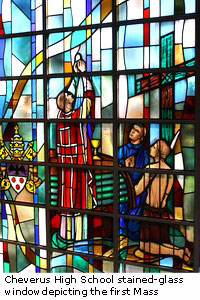 In 1611, Father Pierre Biard, a French Jesuit, traveled the rivers of the Ste. John, Ste. Croix, Penobscot, and Kennebec. According to The Jesuit Heritage in New England, Fr. Biard’s faith-filled impact was immediately felt in his new surroundings, paving the way for missionary work among Maine Indians through the spiritual care of tribes in Pleasant Point, Old Town, Bangor, Castine, and to islands like Monhegan and Matinicus, where he set up the Holy Cross. His letters even refer to tribes in the southern part of Maine. Fr. Biard, and a fellow Jesuit, Fr. Ennemond Massé, were also cordially received by Betsabés, the powerful chief of the Penobscots. It was Fr. Massé who offered the first Mass recorded in New England on Swan Island at the entrance of the Kennebec River on November 1, 1611.
In 1611, Father Pierre Biard, a French Jesuit, traveled the rivers of the Ste. John, Ste. Croix, Penobscot, and Kennebec. According to The Jesuit Heritage in New England, Fr. Biard’s faith-filled impact was immediately felt in his new surroundings, paving the way for missionary work among Maine Indians through the spiritual care of tribes in Pleasant Point, Old Town, Bangor, Castine, and to islands like Monhegan and Matinicus, where he set up the Holy Cross. His letters even refer to tribes in the southern part of Maine. Fr. Biard, and a fellow Jesuit, Fr. Ennemond Massé, were also cordially received by Betsabés, the powerful chief of the Penobscots. It was Fr. Massé who offered the first Mass recorded in New England on Swan Island at the entrance of the Kennebec River on November 1, 1611.
In May of 1613, Fr. Biard and Fr. Massé were joined by two more Jesuits: Jacques Quentin, a priest, and Gilbert Du Thet, a brother, to found Holy Redeemer Mission (Saint Sauveur) near the present town of Bar Harbor. The priests established themselves near Fernald Point as the Penobscots were open to conversion.
Sadly, an English attack destroyed the mission that summer, killing Brother Du Thet, who was interred at the foot of the cross marking the mission. Although the attack began a long, arduous struggle between France and England for control of North America, the historic contributions by these courageous priests will forever be remembered. Today, the church located on Lookout Way in Northeast Harbor is named St. Ignatius, in honor of the founder of the Jesuits, while the church found on Mount Desert Street in Bar Harbor is named Holy Redeemer.
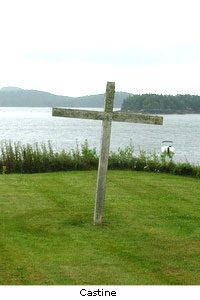 In the decades to follow, Franciscan priests continued the quest to plant the seed of Christianity in Maine. Recollect Franciscans ministered to the Native Americans and French, and in 1633, the Capuchins arrived in the Penobscot River Valley, ministering at a chapel in Castine.
In the decades to follow, Franciscan priests continued the quest to plant the seed of Christianity in Maine. Recollect Franciscans ministered to the Native Americans and French, and in 1633, the Capuchins arrived in the Penobscot River Valley, ministering at a chapel in Castine.
At the request of the Abenakis, Father Gabriel Druillettes, S.J., built a chapel in what is now Augusta in August of 1646, setting the foundation for St. Mary of the Assumption Parish. Fr. Druillettes hunted with neophytes, offered the first Mass in Madawaska, and served as a diplomat in addition to providing spiritual care to the Abenakis. Blessed François de Montmorency Laval, who served as vicar apostolic for the area starting in 1658, reported that approximately 200 baptisms were celebrated at the Assumption Mission between 1660 and 1663, a true testimony to the perseverance of the Jesuit missionaries who served along all the major rivers in what is now the state of Maine.
CHALLENGES OF A FLEDGLING CHURCH
Missionaries continued defending religious freedom for Native Americans throughout the 17th and early 18th century despite the increasing hostilities between France and England over control of the region. Among them, Fr. Jacques Bigot, S.J., and Fr. Vincent Bigot, S.J., who were associated with missions located in western Maine, and Fr. Sebastian Rale, S.J., who was killed along with many Native Americans and chiefs during a famous attack on a mission village in Norridgewock in 1724.
During the Revolutionary War, the scattered Native American communities in Maine were periodically visited by chaplains of the French Navy allied with the rebel cause, but, in 1792, Bishop John Carroll of Baltimore, the first bishop in the newly formed United States of America, recognized the Native Americans’ need for a priest. In 1792, he sent the Sulpician François Ciquard to the Passamaquoddies to whom he provided spiritual guidance on Indian Island and Pleasant Point, and, in 1798, another French refugee, Fr. Jean Lefebvre de Cheverus was sent to serve the Native Americans at Indian Island and to found what would become St. Patrick Parish in Newcastle.
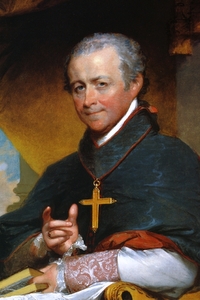 Fr. Cheverus would be appointed the first Bishop of Boston in 1808. That year, he dedicated St. Patrick, now the oldest Catholic Church in New England. In 1811, Fr. Cheverus confirmed 122 Passamaquoddies at Pleasant Point. The Indians had been instructed by another French priest, Fr. Jacques Romagné, who also ministered to a new wave of Catholics in need of pastoral care: Irish immigrants. Parishes in North Whitefield, Eastport, Machias, and Portland followed in close succession to serve growing numbers of Irish immigrants. In 1818, Fr. Dennis Ryan, who had left his native Ireland for Quebec, was named pastor of St. Patrick Parish in Newcastle.
Fr. Cheverus would be appointed the first Bishop of Boston in 1808. That year, he dedicated St. Patrick, now the oldest Catholic Church in New England. In 1811, Fr. Cheverus confirmed 122 Passamaquoddies at Pleasant Point. The Indians had been instructed by another French priest, Fr. Jacques Romagné, who also ministered to a new wave of Catholics in need of pastoral care: Irish immigrants. Parishes in North Whitefield, Eastport, Machias, and Portland followed in close succession to serve growing numbers of Irish immigrants. In 1818, Fr. Dennis Ryan, who had left his native Ireland for Quebec, was named pastor of St. Patrick Parish in Newcastle.
In 1825, Bishop Benedict Fenwick was named second Bishop of Boston, which included Maine. In addition to sending priests like Fr. Virgil Barber, S.J., to continue ministering to Native Americans, the bishop dedicated a new church in North Whitefield in 1838 for nearly 500 Irish farmers and founded a utopian Catholic farming community at Benedicta for Irish immigrants in 1834. In 1835, the bishop dedicated St. Dominic Church in Portland and established several new parishes over the course of the next decade. He appointed Fr. James Power, former prefect of discipline at Holy Cross College in Massachusetts, as pastor of St. Dominic. Fr. James O’Reilly celebrated the first Mass in Auburn in 1848 and Fr. Charles McCullion celebrated the first Mass in Lewiston in 1850.
Bishop Fenwick’s efforts to expand Catholicism in Maine were extraordinary, but his successor, John Bernard Fitzpatrick, appears to have focused on returning Jesuit priests back to Maine to serve in the growing communities of Irish, French, and Italian immigrants. In 1848, he arranged for the Society of Jesus to assume responsibility for the Indian missions of Maine and other churches. Fr. John Bapst and his companions served in over 40 churches and chapels during this period, reviving the missions among the Passamaquoddies and the Penobscots while ministering to growing cities like Portland.
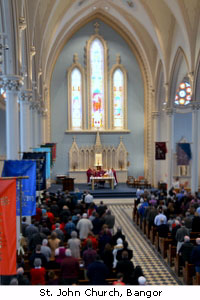 During this period, Catholic priests in Maine faced violence and anti-Catholic prejudice. In the 1850s, churches were burned in Bath and Lewiston, and a mob in Ellsworth tarred and feathered Fr. Bapst in October of 1854. In December of that year, Bishop Fitzpatrick blessed St. John Church in Bangor and the cornerstone contained a bottle with a relic of the tarring and feathering of Father Bapst. Determined Irish Catholics had stood watch during the church’s construction. The Catholic Church in Maine was undeniably growing in number, fervor, and faithfulness. In a tribute to a priest who had given their area so much, today, John Bapst High School stands on Broadway in Bangor.
During this period, Catholic priests in Maine faced violence and anti-Catholic prejudice. In the 1850s, churches were burned in Bath and Lewiston, and a mob in Ellsworth tarred and feathered Fr. Bapst in October of 1854. In December of that year, Bishop Fitzpatrick blessed St. John Church in Bangor and the cornerstone contained a bottle with a relic of the tarring and feathering of Father Bapst. Determined Irish Catholics had stood watch during the church’s construction. The Catholic Church in Maine was undeniably growing in number, fervor, and faithfulness. In a tribute to a priest who had given their area so much, today, John Bapst High School stands on Broadway in Bangor.
By 1855, priests were faced with an increasing number of French Canadians, looking for pastoral care as they arrived in Maine to work in the cotton mills, and Irish immigrants, who were living in Maine as they built the railroad system. Priests coped with Protestant influence and the burning of churches. After rebuilding it twice, St. Joseph Church in Lewiston, with Fr. John Cullen as resident priest, was dedicated in 1869.
St. Mary of the Assumption Church was established in Biddeford in 1858, a year before the Jesuits were recalled from Maine. The street on which the original church stood was named Vetromile Street after Fr. Eugene Vetromile, who served the new diocese as a Jesuit from 1854 to 1858. Upon the departure of the Jesuits, Fr. Vetromile became a diocesan priest and, subsequently, was named pastor of the church. In 1869, Fr. Richard Duddy was the first native of Portland to be ordained a priest, serving in 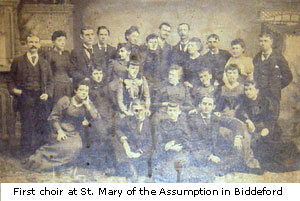 Lewiston, Old Town, and Winterport.
Lewiston, Old Town, and Winterport.
By 1870, nearly a quarter of Maine Catholics were French speaking. After the Civil War, priests like Fr. Pierre Hévey, Fr. David Halde, Fr. Charles Sweron, and Fr. Jean-Francois Ponsardin provided priestly ministry for the French, who increasingly wanted their own national parishes in larger population areas. Priests, in addition to their parish duties, were also asked to work with the Sisters of Mercy to establish Catholic schools in Bangor, North Whitefield, and Portland.
THE BIRTH OF A NEW DIOCESE
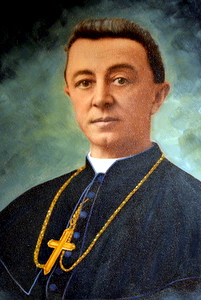 In 1875, Bishop James Augustine Healy was ordained as the nation’s first African-American bishop at the Cathedral of the Immaculate Conception in Portland. In his 25 years as Bishop of Portland, Bishop Healy founded 33 parishes, 22 schools, 18 convents, and a small number of hospitals and orphanages. The Catholic population in Maine was just short of 100,000 by 1900. The wonderful growth of the Church in Maine required the contributions of additional priests. Bishop Healy invited the first religious men into the diocese in 1881 as the Dominican Friars arrived to assist at St. Peter Parish in Lewiston, a thriving community of 5,000 Franco-American Catholics. By the turn of the century, there were nine priests and five brothers serving at the parish. Fr. John Murphy, with the assistance of the Brothers of Christian Schools, had turned St. Mary Catholic School into a significant educational center. In 1888, Fr. Narcisse Charland, renowned pastor of St. Francis de Sales Parish in Waterville, brought the Ursulines to the city from Quebec to assist at a time in which Roman Catholics represented nearly half of the city’s population of 7,500.
In 1875, Bishop James Augustine Healy was ordained as the nation’s first African-American bishop at the Cathedral of the Immaculate Conception in Portland. In his 25 years as Bishop of Portland, Bishop Healy founded 33 parishes, 22 schools, 18 convents, and a small number of hospitals and orphanages. The Catholic population in Maine was just short of 100,000 by 1900. The wonderful growth of the Church in Maine required the contributions of additional priests. Bishop Healy invited the first religious men into the diocese in 1881 as the Dominican Friars arrived to assist at St. Peter Parish in Lewiston, a thriving community of 5,000 Franco-American Catholics. By the turn of the century, there were nine priests and five brothers serving at the parish. Fr. John Murphy, with the assistance of the Brothers of Christian Schools, had turned St. Mary Catholic School into a significant educational center. In 1888, Fr. Narcisse Charland, renowned pastor of St. Francis de Sales Parish in Waterville, brought the Ursulines to the city from Quebec to assist at a time in which Roman Catholics represented nearly half of the city’s population of 7,500.
The era also marked the beginning of long tenures for many pastors like Fr. Francois Trudel, who served as pastor in Old Town for nearly four decades; Fr. Thomas Butler, who served as pastor of St. Joseph Parish in Ellsworth (1881-1894) and St. Joseph Parish in Lewiston (1894-1917); Fr. Joseph Ahern, who was pastor in Eastport for at least 25 years; Fr. Jeremiah McCarthy, pastor of St. Mary Parish in Bangor who server for nearly 25 years; and Fr. Charles Doherty, who served as pastor of St. Mary Parish in Augusta from 1886 to 1910. By the time of Bishop Healy’s death, there were over 50 parishes in the state, each with a resident priest.
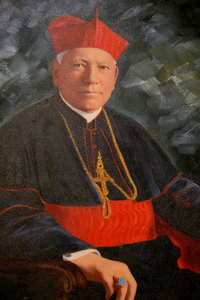 During the episcopacy of Bishop William O’ Connell, priests in the diocese began submitting an annual parish report, including financial information and attendance figures. Priests were asked to create welcoming parish communities for a wave of new immigrants from Italy and Poland as they had for those arriving from Ireland, Germany, and France. Between 1901 and 1906, the number of priests in the diocese grew from 101 to 121.
During the episcopacy of Bishop William O’ Connell, priests in the diocese began submitting an annual parish report, including financial information and attendance figures. Priests were asked to create welcoming parish communities for a wave of new immigrants from Italy and Poland as they had for those arriving from Ireland, Germany, and France. Between 1901 and 1906, the number of priests in the diocese grew from 101 to 121.
By the end of the 20th century’s first decade, a new focus for priests had emerged: the spiritual welfare of new immigrants from Italy, Poland, and other countries. For example,
• Fr. Antonio Petillo, a native of Salerno, assisted at the Cathedral in Portland between 1907 and 1909. In 1910, Fr. Agnello Santagnello arrived in Portland and offered Mass for Italians in the Kavanagh School until the diocese converted a structure into a chapel on Federal Street. Fr. Petillo returned to the diocese in 1914 to serve at St. Peter in Portland.
• Bishop Louis S. Walsh opened a mission for Polish Catholics at St. Dominic in Portland in 1915. Fr. John Sciskalski, a Vincentian, served the community until the appointment of Fr. Peter Pojnar in 1917. A church and hall were constructed for the Polish Catholics in 1924, eventually becoming St. Louis Parish in Portland.
• Fr. Norbert Pakalins ministered to Lithuanian immigrants in Lewiston.
• Fr. Joseph Award cared for a growing Syrian population in Waterville.
• Fr. Honorius Frastacky, a Franciscan, served the Slovakian community in Lisbon Falls.
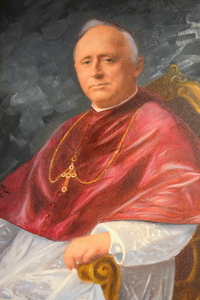 In addition, Bishop Walsh had a policy that if any pastor could not speak the language of a nationality present, the pastor would invite a priest of that ethnic background to visit at least twice a year.
In addition, Bishop Walsh had a policy that if any pastor could not speak the language of a nationality present, the pastor would invite a priest of that ethnic background to visit at least twice a year.
In 1908, with the help of priests like Fr. John Kealy and Fr. Philippe Desjardins, the bishop founded the Maine Catholic Historical Society. Bishop Walsh gave special attention to honoring the memory of the courageous and faith-filled priests who served the state, including the dedication of a new church, St. Sebastian in Madison, in honor of Fr. Sebastian Rale, S.J., who was killed along with many Native Americans in during an attack on a mission village in Norridgewock in 1724.
Bishop Walsh, who had served as superintendent of schools for the Archdiocese of Boston, raised the enrollment at Catholic schools in the state to over 20,000. Priests of the diocese assisted in this incredible endeavor, for instance, teaching at the Catholic Institute, a high school for boys in Portland. Between 1906 and 1924, the number of priests in the diocese grew from 121 to 167, serving 95 parishes and 73 mission churches.
Throughout the diocese’s history, priests have been called upon to lead initiatives and address issues deemed pressing or significant by the sitting bishop. During the episcopacy of Bishop John Gregory Murray, pastors were urged to visit the sick in their parishes at least once a day.
Priests continued to play a crucial role in education throughout the diocese. In 1926, Catholic Institute in Portland was renamed Cheverus in honor of one of the state’s early and impactful missionaries, Fr. Jean Lefebvre de Cheverus. Fr. Clarence Coughlin, who would later serve as Chancellor of the diocese for 28 years, was named its first principal. Fr. Daniel J. Feeney was appointed the first Diocesan Superintendent of Schools in 1926. In 1927, John Bapst High School opened in Bangor, with diocesan priests and the Sisters of Mercy serving as teachers. Two pastors in Bangor, Fr. Thomas Nelligan and Fr. Martin Clary, were instrumental in the establishment of the school.
THE MAINE CHURCH IN A TIME OF VIGOROUS GROWTH
Catholic influence was spreading. In 1927, St. Joseph Maronite Church for the Syrian community was established in Waterville with Fr. Joseph Awad serving as pastor, and, by the end of Bishop Murray’s tenure, over 175,000 Catholics lived in Maine. Between 1925 and 1931, the number of priests in the diocese grew from 176 to 216, with an increase of resident pastors from 95 to 126.
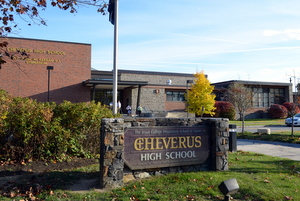 Jesuit priests, apart from occasional mission and retreat work, had largely been absent from the diocese for decades. At the invitation of Bishop Joseph E. McCarthy, the Society of Jesus took charge of the operation of Cheverus High School and were helpful in providing priests to minister for diocesan churches. A new Cheverus High School was dedicated at its present-day Ocean Avenue location in 1952. Fr. Edmund Walsh, pastor of Sacred Heart Parish in Yarmouth, secured land and funding for the new school from generous benefactors, the Woolworths. In addition to preparing young men for college and a career, the Jesuits were also called upon for special assignments during World War II, ministering on the islands in Casco Bay, at military installations, and in such towns as Westbrook, Limerick, and York Beach. Fr. James J. Shaw, S.J., who served at Sacred Heart in Waterville from 1950 to 1968, rose to the rank of lieutenant colonel in the Army because of his personal service in World War II. Msgr. Robert J. White became the first naval chaplain with the rank of commodore to serve in active duty, retiring as a rear admiral.
Jesuit priests, apart from occasional mission and retreat work, had largely been absent from the diocese for decades. At the invitation of Bishop Joseph E. McCarthy, the Society of Jesus took charge of the operation of Cheverus High School and were helpful in providing priests to minister for diocesan churches. A new Cheverus High School was dedicated at its present-day Ocean Avenue location in 1952. Fr. Edmund Walsh, pastor of Sacred Heart Parish in Yarmouth, secured land and funding for the new school from generous benefactors, the Woolworths. In addition to preparing young men for college and a career, the Jesuits were also called upon for special assignments during World War II, ministering on the islands in Casco Bay, at military installations, and in such towns as Westbrook, Limerick, and York Beach. Fr. James J. Shaw, S.J., who served at Sacred Heart in Waterville from 1950 to 1968, rose to the rank of lieutenant colonel in the Army because of his personal service in World War II. Msgr. Robert J. White became the first naval chaplain with the rank of commodore to serve in active duty, retiring as a rear admiral.
Over 100 new priests were ordained during Bishop McCarthy’s episcopacy, growing the number of priests in the Diocese of Portland to over 225.
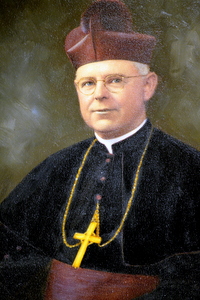 In 1955, Bishop Daniel J. Feeney, who had served as the first Diocesan Superintendent of Schools and as Auxiliary Bishop, was appointed the new Bishop of Portland. In this period, diocesan priests oversaw the growth of Catholic religious and social organizations like the Knights of Columbus, the Holy Name Society, and the Daughters of Isabella. The first Catholic Youth Organization in Maine was organized in Presque Isle by Fr. Royal Parent, promoting the social, athletic, and spiritual growth of parish youth. Thanks to the contributions of Fr. Parent and other priests, the C.Y.O. spread throughout the state.
In 1955, Bishop Daniel J. Feeney, who had served as the first Diocesan Superintendent of Schools and as Auxiliary Bishop, was appointed the new Bishop of Portland. In this period, diocesan priests oversaw the growth of Catholic religious and social organizations like the Knights of Columbus, the Holy Name Society, and the Daughters of Isabella. The first Catholic Youth Organization in Maine was organized in Presque Isle by Fr. Royal Parent, promoting the social, athletic, and spiritual growth of parish youth. Thanks to the contributions of Fr. Parent and other priests, the C.Y.O. spread throughout the state.
In 1955, 15 candidates were ordained to the priesthood, the largest class in the diocese’s history.
The decrees of the Second Vatican Council (1962-1965) were successfully implemented in the diocese. A senate, elected by priests, was established to help the bishop govern the diocese. In the late 1950s and 1960s, a number of prominent pastors passed away, including Fr. Philippe Desjardins, pastor of St. Hyacinth in Westbrook, who, at the age of 92, died in 1969. The impact of these transformative priests, including Monsignors Arthur Décary and Joseph Laflamme, pastors in Biddeford, who helped guide the diocese through the Great Depression and World War II can still be felt today.
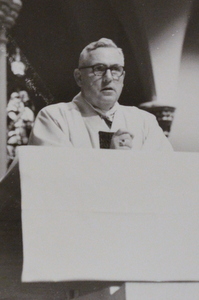 In the 1970s, a new era of fruitful cooperation between priests and laity was facilitated by Bishop Peter L. Gerety. Priests and lay people served together on the Diocesan Pastoral Council, the Priests’ Personnel Board, and through the Diocesan Hospital Chaplaincy. In addition to their parish duties, priests continued to contribute to higher education as Bishop Gerety established the Newman Center of Our Lady of Wisdom in Orono and the Diocesan Campus Ministry Apostolate, which had its own vicar.
In the 1970s, a new era of fruitful cooperation between priests and laity was facilitated by Bishop Peter L. Gerety. Priests and lay people served together on the Diocesan Pastoral Council, the Priests’ Personnel Board, and through the Diocesan Hospital Chaplaincy. In addition to their parish duties, priests continued to contribute to higher education as Bishop Gerety established the Newman Center of Our Lady of Wisdom in Orono and the Diocesan Campus Ministry Apostolate, which had its own vicar.
In 1972, Fr. J. Stanley Bowe, S.J. became the first Jesuit in a century to be appointed to the Passamaquoddy Indian reservation at Pleasant Point. The assignment recalled the amazing relationship between the Indians and Jesuits, who first brought the faith to the Abenakis and stood by their side as they fought for justice.
During this period, priests also helped successfully launch the Diocesan Bureau of Human Relations Services, now known as Catholic Charities Maine. Priests reached out to the people of Maine at seven homes for the elderly, six general hospitals, four day care centers, and through the operation of many district offices. The priests were enthusiastically involved in spreading a social gospel to the benefit of those in material and spiritual need. A new spirit of togetherness, confidence, and shared accomplishment spread among the priests, who were facing a decline in numbers.
RECENT CHALLENGES AND OPPORTUNITIES
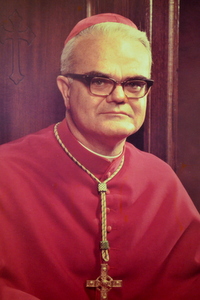 Bishop Edward C. O’Leary was beloved by those to whom he ministered. Prior to being appointed Bishop of Portland in 1974, he served at the Cathedral of the Immaculate Conception in Portland, St. Margaret Parish in Old Orchard Beach, and St. Charles Borromeo Parish in Brunswick.
Bishop Edward C. O’Leary was beloved by those to whom he ministered. Prior to being appointed Bishop of Portland in 1974, he served at the Cathedral of the Immaculate Conception in Portland, St. Margaret Parish in Old Orchard Beach, and St. Charles Borromeo Parish in Brunswick.
Bishop O’ Leary was concerned about the priests whom he regarded as his coworkers in fulfilling the mission of the Catholic Church. While the Catholic population in the diocese expanded to over 266,000 during his tenure, the number of priests dipped from 345 to 297. Of that number, active diocesan priests dropped from 203 to 156, necessitating increased contributions from religious priests. The Holy Cross Fathers operated Most Holy Trinity in Saco; the Jesuits assumed responsibility of St. Dennis in North Whitefield and St. John in Bangor; and the Franciscans took over St. Joseph in Portland and helped at St. Peter, also in Portland. Historically, Fr. Paulius Baltakis, a Lithuanian Franciscan, was ordained a bishop in the Cathedral in Portland in 1984.
In the 1970s and 80s, priests began to be faced with the consequences of developments in the American society including legislation involving abortion, physician-assisted suicide, capital punishment, and pornography.
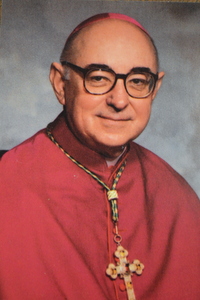 By the mid-1990s, the number of priests serving under Bishop Joseph J. Gerry, O.S.B., was about 150, slightly more than two-thirds of which were diocesan priests. More priests were needed to provide for the faithful in Maine. Bishop Gerry continued the work of Bishop O’ Leary in addressing the trend as an increasing number of parishes began to share a pastor; a former Anglican priest, Fr. Richard Senghas, the father of seven and married prior to conversion, was accepted as a priest in the diocese; and a Marian priest from Poland, was named pastor of St. Louis Parish in Portland.
By the mid-1990s, the number of priests serving under Bishop Joseph J. Gerry, O.S.B., was about 150, slightly more than two-thirds of which were diocesan priests. More priests were needed to provide for the faithful in Maine. Bishop Gerry continued the work of Bishop O’ Leary in addressing the trend as an increasing number of parishes began to share a pastor; a former Anglican priest, Fr. Richard Senghas, the father of seven and married prior to conversion, was accepted as a priest in the diocese; and a Marian priest from Poland, was named pastor of St. Louis Parish in Portland.
In recent years, priests have dealt with a host of issues like social unrest, civil rights, and the clergy abuse scandal which led to tragedy and challenges disrupting Catholic life. The grave failings of some have been both a cause of shame and humiliation to many. In the midst of these difficulties, today’s priests are driven by the abiding presence and strength of Jesus within them. They meet the adversity of the past with a renewed spirit, bringing the person of Jesus to the people they serve. The awesome responsibility is also a wonderful grace; a life that priests are privileged to share.
The Catholic faith has been preached, confessed, and celebrated here in this beautiful land for over 400 years. Brought by the French missionaries under the sign of the Holy Cross which now decorates the Diocesan seal, it was embraced by the Native Americans who already dwelt peacefully in these lands before the explorations of English and French. Over succeeding generations, even to our day, it has been proclaimed and confessed by the new peoples settling in this land. Priests are a part of a wonderful tradition which connects us to the past and sends us forward into the future to do what has been done – to proclaim the Gospel---the source of joy and meaning for our lives. Priests, serving people generously while providing pastoral care selflessly, accept their vocation each day, living their fidelity to the mission that the Church entrusts to them.

